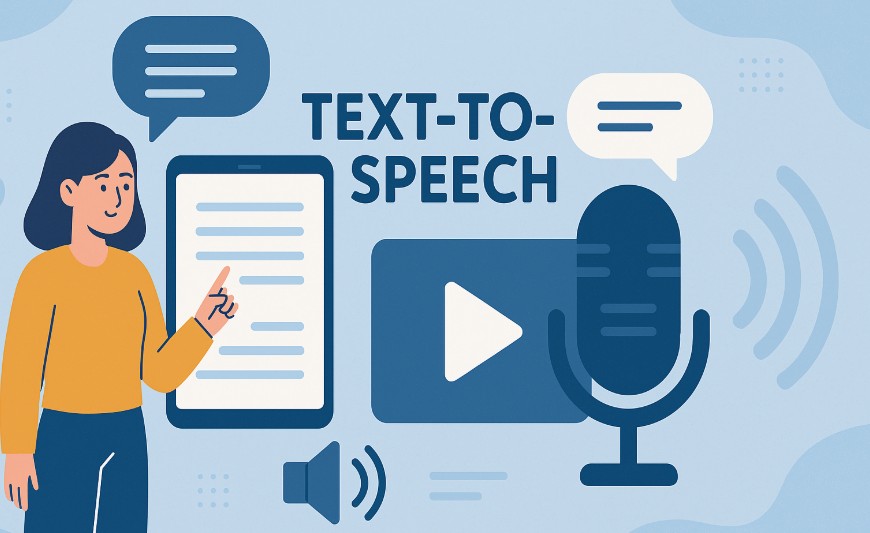In the modern-day constantly changing digital and globalized environment, accessibility in the workplace is no longer an afterthought but a fundamental requirement. Businesses are seeing the enormous advantage of having inclusive workplaces where all workers, regardless of their ability, can work and offer their own unique strengths.
A very important tool behind this change is Text-to-Speech (TTS) technology. Instead of simply translating written words into voice audio, TTS is playing a crucial component in building equitable and inclusive workplaces.
5 ways TTS Technology is Improving Workplace Accessibility
These are five key ways TTS technology is making workplaces more accessible.
1. Disabling Employee Barriers to Information

The immediate and most significant effect of TTS technology is the potential to disable barriers to information for employees with disabilities or visually impaired individuals.
They might be unable to carry out their job responsibilities because information is inaccessible due to their disability. TTS reads out such unreadable text, and they are readily able to comprehend documents, emails, presentations, and web content.
Similarly, dyslexic staff or those with other reading disabilities might not be able to comprehend written material. TTS provides an alternative path to comprehension and enables them to process information effectively and confidently.
This extends beyond mere reading text out loud. Advanced TTS solutions allows users to be in control of the reading speeds, highlighting, and navigation so that individuals can make the experience suit their requirements.
By delivering equal access to information, TTS promotes inclusivity, minimizes workplace inequalities, and enables workers with disabilities to fully engage in their work.
2. Learning and Training Accessible to Everyone
Learning and professional development are all part of career progression and advancement. Yet conventionally used training materials, depending heavily on textual documents and slides, can become a major difficulty for disabled staff.
TTS provides the solution by rendering the materials into available audio formats. Consider an employee with dyslexia easily hearing a training module during their travel time or a visually disabled colleague reading an intricate technical manual through a clear-sounding synthesized voice.
This not only enhances access but also improves interaction and comprehension for everyone working because audio learning is generally found to be more effective and engaging than reading.
Also, TTS can be utilized to create interactive training modules with embedded audio elements, thus improving learning and accessibility.
3. Increased Productivity: Fostering Multitasking and Time Management

In the current fast-paced work culture, productivity is of utmost importance. TTS technology can greatly improve productivity by allowing employees to multitask and better manage their time.
For example, employees can listen to emails or reports while commuting, exercising, or performing other tasks that do not require visual attention. This frees up valuable time for other important tasks, leading to increased efficiency.
In addition, TTS is also used to produce audio abstracts of long documents or presentations so that employees will be able to easily understand important information without going through pages of the document.
This would be particularly useful for workers with tight timetables who have to assimilate a great deal of information in a matter of hours. Through effective time management and enabling multitasking, TTS enables workers to work smart and accomplish more.
4. Enables Remote Work and Collaboration: Overcoming Geographical Distances
Remote work and virtual collaboration has revolutionized the contemporary workplace. Nevertheless, remote work can also give rise to special accessibility barriers.
Disabled employees might encounter barriers to accessing information or attending virtual meetings because of environmental and technological limitations.
TTS technology bridges such geographical barriers as it allows employees to access information and attend meetings from anywhere in the world, independent of physical location or disability.
For example, workers can leverage TTS in listening to meeting transcripts or documents presented during virtual meetings. This makes information equally accessible to all, allowing them to contribute appropriately to conversations.
Moreover, TTS can be used to create accessible audio recordings of meetings so that workers who cannot attend the live session can listen in their own time. This helps in creating a virtual work environment where everyone can fully participate, regardless of time differences and language barriers.
5. Wider Language Support: Reducing Communication Barriers

In the contemporary globalized world, workplaces are becoming more multilingual, and workers come from different linguistic groups. Language limitations can hamper communication and interaction, especially among non-native speakers.
TTS technology provides the answer by bridging language support, enabling employees to access knowledge and communicate naturally in their first language.
Next-gen TTS solutions can translate texts into multiple languages and deliver speech that sounds as human-like as everyday conversation. This means that employees can read documents, emails and training materials in their native language, boosting comprehension and collaboration.
Also, TTS can be used to generate multilingual audio for meetings and presentations so that everyone can contribute as much as anyone else, regardless of language proficiency. By eliminating barriers to communication, TTS promotes a more equitable and inclusive work environment.
In summary, TTS technology is an effective solution for making the workplace more accessible and inclusive.
By eliminating obstacles to information, enhancing engagement, maximizing time management, supporting remote work, and encouraging multilingual communication, TTS empowers all workers, with or without disabilities, and enables a more balanced and productive work environment for all.
Author Profile

- Blogger by Passion | Contributor to many Business Blogs in the United Kingdom | Fascinated to Write Blogs in Business & Startup Niches |
Latest entries
 FinanceOctober 28, 2025How to Measure the ROI of Your Promotional Product Campaigns?
FinanceOctober 28, 2025How to Measure the ROI of Your Promotional Product Campaigns? Home & LivingOctober 4, 2025Moving Forward When Leicester Family Dynamics Change
Home & LivingOctober 4, 2025Moving Forward When Leicester Family Dynamics Change BusinessSeptember 22, 2025Always-On SMEs: The UK Business Owner’s Guide to Seamless Travel Data for Sales Trips, Trade Fairs & Remote Teams
BusinessSeptember 22, 2025Always-On SMEs: The UK Business Owner’s Guide to Seamless Travel Data for Sales Trips, Trade Fairs & Remote Teams GamingSeptember 19, 2025Are UK Players Still Able to Play on European Online Casinos?
GamingSeptember 19, 2025Are UK Players Still Able to Play on European Online Casinos?





